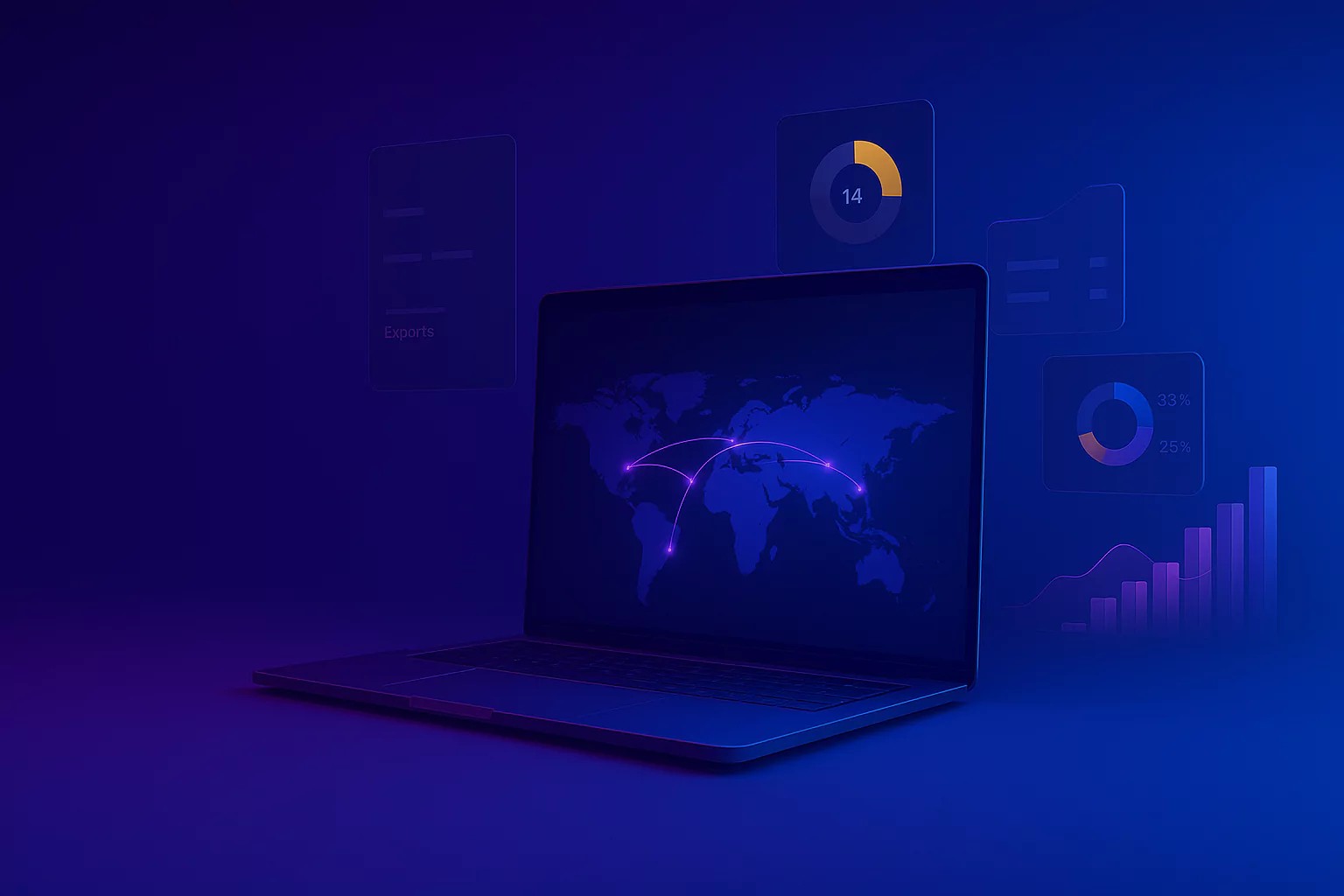Beyond Aesthetics: The Strategic Value of Graphic Design in Business
Beyond Aesthetics: The Strategic Value of Graphic Design in Business
As businesses evolve, so must the creativity and sophistication of their visual strategies. Brands that implement advanced graphic design strategies can create more engaging, impactful, and culturally aware designs that propel brands forward.
Graphic design in contemporary businesses extends far beyond just aesthetics. It is a strategic asset that enhances brand identity, communicates core values, and engages targeted audiences effectively. An effective graphic design helps companies translate complex data into digestible visual formats, simplifies user interactions through intuitive interfaces, and evokes emotional responses that influence consumer behavior.
Put simply, graphic design not only shapes the visual narrative of a company but also helps achieve its goals by harmonizing with its strategic marketing and communication strategy.
The Spectrum of Corporate Graphic Design
The spectrum of corporate graphic design is vast and varied. It encompasses a range of disciplines that collectively enhance and define a company’s visual identity. This spectrum is crucial not only for maintaining consistency across all media but also for ensuring that every piece of design work aligns with the company’s strategic goals.
From Logos to Corporate Communication: A Broad View
Corporate branding is more than just logo design – it’s the art of aligning a company’s identity with its communications across every platform and interaction. As companies face an increasingly competitive and digital-first market, innovative design solutions are pivotal in setting them apart and forging deeper connections with their audiences. Here’s an overview of how innovation in design is pushing corporate branding forward across various dimensions:
Dynamic Logos and Adaptive Branding
Forward-thinking companies are redesigning their logos to be not only visually appealing but also flexible. These dynamic logos adapt seamlessly across various contexts—whether for marketing campaigns, special events, or digital platforms. This ensures the brand stays relevant and engaging across all platforms. A prime example is Google’s homepage, which features ever-changing doodles that keep the brand fresh and relevant every day.
Sustainability in Branding
As sustainability becomes more critical, brands are integrating eco-friendly practices into their design strategies. For instance, Patagonia has continued its sustainability efforts by launching an eco-conscious apparel line, emphasizing its use of recycled materials. This sustainable approach is also evident in their packaging and promotional materials, which are made from recycled paper, coupled with their use of soy-based and algae-based inks.
Cultural Sensitivity in Global Markets
As brands expand globally, cultural sensitivity in design becomes essential. Adapting visuals, slogans, and strategies to different cultural contexts is key to preserving the core brand identity. For instance, Coca-Cola’s “Share a Coke” campaign featured local names on bottles and tailored advertisements to mirror local cultures and languages. This strategy enhanced local relevance and upheld Coca-Cola’s global identity, deepening connections with consumers worldwide.
Innovative Design Solutions for the Corporate World
Companies that adopt innovative design solutions not only stand out from the competition but also create more engaging experiences for their customers. At its core, innovative corporate design must be functional, appealing, and reflective of a company’s brand identity. It should focus on usability, simplicity, and creating memorable experiences. Whether it’s a digital interface’s layout or a corporate headquarters’s architectural design, every design decision impacts user interaction and brand perception.
Leveraging Technology and Creativity for Brand Distinction
By leveraging both technology and creativity, graphic design not only enhances brand distinction but also significantly contributes to a company’s digital transformation strategy. Here’s how graphic design is pivotal in this context:
Enhancing Brand Identity
Graphic design is instrumental in crafting a visual identity that reflects a brand’s ethos, values, and objectives. A strong brand identity is more than just a memorable logo – it encompasses a consistent theme across all digital platforms, including website design, social media, and online advertisements. This consistency helps in establishing brand recognition and loyalty among consumers.
Improving User Experience
Good design is crucial for creating user-friendly digital interfaces. A well-thought-out design not only draws in users but also makes their journey through your website or app effortless and enjoyable. This is especially vital for retaining users, as a positive interaction with your digital properties can boost customer satisfaction and loyalty.
Simplifying Communication
Visual content communicates messages more effectively than text alone. Graphic design helps break down complex information into engaging visuals like infographics, videos, and animations, making it easier for audiences to digest and remember information. This is incredibly useful in marketing, where grabbing and sustaining audience attention quickly is paramount.
Supporting Marketing and Advertising
Graphic design is at the heart of digital marketing and advertising. Whether it’s creating striking digital banners, BIMI logo, designing sleek email campaigns, or crafting interactive ads, compelling visuals are key to attracting attention and prompting consumer action.
Boosting Social Media Engagement
Social media platforms are visually driven. Effective graphic design ensures that posts, ads, and updates stand out. This can lead to increased engagement rates, broader reach, and higher conversion rates.
Graphic Design’s Role in Digital Transformation
Graphic design isn’t just a support tool in digital transformation – it is a transformative force in its own right. Let’s delve deeper into the integral role graphic design plays in the success of digital transformations.
How Design Accelerates Digital Branding and Presence
Incorporating sustainability into corporate graphic design is a reflection of a brand’s commitment to environmental and social responsibility. This approach not only enhances a brand’s appeal but also strengthens its digital presence in a marketplace that increasingly values ethical standards. Here’s how integrating sustainable practices into graphic design can profoundly influence a brand’s identity and consumer relationships:
Reflecting Core Values
Sustainable graphic design reflects the principles of sustainable product design by focusing on optimizing the lifecycle of digital assets to reduce their environmental, economic, and social impacts. This approach could include using energy-efficient servers for hosting websites or choosing eco-friendly tools for creating digital content.
Enhancing Customer Loyalty and Engagement
Today’s consumers increasingly base their purchasing decisions on how environmentally responsible a company is. According to Salesforce’s 2022 State of the Connected Customer survey, 78 percent of customers say that a company’s environmental efforts influence their purchasing decisions. By adopting sustainable graphic design practices, like using biodegradable materials for promotional items or reducing digital clutter in email marketing, brands can showcase their commitment to the environment. This not only helps the planet but also boosts customer loyalty, as consumers feel more aligned with brands that share their values.
Driving Revenue Growth and Cost Savings
Sustainable graphic design helps cut down on resource usage, for example, by creating impactful content that is less resource-intensive or by digitizing materials that are typically printed. This approach not only lowers production costs but also appeals to customers looking for responsible brands, thereby boosting sales.
Attracting Investment
With a growing emphasis on environmental, social, and governance (ESG) criteria among investors, brands that demonstrate a strong commitment to sustainability become more attractive investment opportunities. Sustainable graphic design visibly communicates a company’s dedication to these practices. According to a survey of senior product design and engineering leaders, 76 percent of manufacturers reported an increase in their ability to attract capital thanks to their sustainable practices.
Setting the Stage for Long-term Business Models
Implementing sustainable practices in graphic design isn’t just about reaping immediate benefits; it’s about preparing for a sustainable future. This approach encourages companies to think creatively about reusing, reducing, and recycling digital assets and to continuously innovate. Such a mindset paves the way for circular business strategies, which aim to keep resources in use as long as possible and add ongoing value to the business.
Sustainable Design in Corporate Branding
Sustainable design has evolved from a niche trend to a fundamental aspect of corporate branding. As awareness of environmental issues grows globally, businesses are increasingly committed to incorporating sustainability into their branding strategies. This shift goes beyond reducing ecological footprints – it also resonates deeply with a growing number of consumers who prioritize environmental values in their purchasing decisions.
Embracing Eco-friendly Practices and Messaging
While it is crucial to embrace eco-friendly practices in corporate branding, communicating these efforts effectively to the public is equally important. Data visualization and infographics are powerful tools that can transform how companies share their sustainability initiatives with the public. Here’s how they enhance communication:
Simplifying Complex Data
Sustainability reports often contain complex data that can be overwhelming for the average reader. Data visualization simplifies this information, presenting it in an easy-to-understand format. By using charts, graphs, and other visual aids, companies can convey important information about their environmental impact—like energy savings, waste management, and resource usage—in a simple and accessible way.
Reinforcing Brand Identity
Integrating data visualization and infographics into sustainability communications can also reinforce a brand’s identity as a leader in eco-friendly practices. Consistent use of design elements that reflect a commitment to the environment helps establish a brand’s reputation as an innovator and thought leader in eco-friendly practices.
Boosting Engagement
Infographics are not just informative – they’re also visually appealing. They combine striking graphics with concise language to catch the viewer’s attention. Companies that integrate eye-catching design elements with key facts about their sustainable practices can engage a broader audience. More importantly, these tools can educate consumers about climate change and illustrate how specific eco-friendly practices can make a significant difference.
Storytelling with Impact
Infographics enable companies to craft engaging narratives about their journey toward sustainability. Through timelines, diagrams, and before-and-after comparisons, they can chronicle their progress, celebrate milestones, and share future goals. This form of storytelling doesn’t just inform—it inspires and encourages broader participation in environmental efforts.
Data Visualization and Infographic Strategy
Creating effective data visualizations and infographics isn’t just about having a knack for design. It involves a deep understanding of the data at hand, knowing your audience, and having clear objectives for your communication. Whether you’re a business leader needing to share insights with stakeholders or a marketer trying to capture consumer interest, developing a robust strategy in this area can significantly enhance how your message is received.
Enhancing Corporate Reports and Presentations
Striking the right balance between modern design trends and timeless branding is essential for creating impactful and memorable digital content. Corporate reports and presentations are not just about conveying information. They are also an extension of a company’s brand identity and values. As such, integrating the latest design trends while maintaining the core elements of timeless branding can significantly elevate the effectiveness and professionalism of these documents. The following are key strategies to achieve this balance:
Staying True to Timeless Branding
The foundation of a company’s visual identity is its timeless branding. Any adoption of new trends mustn’t distort or overshadow this established identity. For instance, a company’s logo, which epitomizes its brand, should remain largely unaffected by passing trends. This ensures that the core visual elements remain consistent and recognizable across all platforms and materials.
Strategic Use of Design Trends
While it’s essential to uphold a timeless brand, selectively integrating modern design trends can revitalize and add dynamism to a company’s marketing and communication efforts. Design trends should complement, not replace, the foundational branding elements. They can be particularly effective in temporary campaigns such as promotions, special events, or digital graphics intended for short-term use.
Balancing Trends and Branding
One common trend in recent years is the resurgence of retro and vintage design elements, such as banners, seals, flags, badges, and distressed typography. These can offer a nostalgic appeal and stand out visually. However, these elements must be carefully integrated with the company’s existing branding to ensure they do not overwhelm or conflict with the established brand message.
Navigating Short-Lived Trends
The transient nature of design trends poses a challenge: what is trendy today may soon be outdated. This is particularly significant for digital assets like websites, which require consistency and longevity more than temporary marketing materials. Companies must remain agile, frequently consulting with design professionals to discern which trends are enduring and which might quickly become obsolete.
Decision-Making with Brand Standards
Every company with a defined brand identity has brand standards that include color schemes, typefaces, logo usage, and layout configurations. These standards should serve as the guiding framework when incorporating trends into new designs. By doing this, companies ensure that even the most contemporary designs feel like a natural extension of their existing brand.
Navigating Design Challenges in the Digital Age
As technology evolves and consumer preferences change, designers need to be flexible, quickly adapting to new tools and platforms while closely monitoring user behavior and expectations. Their aim is to perfectly integrate aesthetics with usability, crafting experiences that are visually appealing and simple to use.
Balancing Trendiness and Timelessness
Below are some frequently asked questions about navigating design challenges in corporate environments. The aim is to strike the right balance between current design trends and timeless appeal.
How can a business integrate current design trends without compromising its brand’s timeless appeal?
Successful integration of current trends involves identifying elements that can complement your brand without overshadowing its foundational identity. Employ trends selectively—for instance, in temporary campaigns or specific digital platforms—where they can inject freshness and relevance without permanently altering your brand’s established design. It’s more about enhancing than transforming.
What strategies can help ensure a design stays relevant in a fast-evolving digital landscape?
Keep your design strategy fresh by staying updated with new tools, technologies, and design trends. Regularly engage with your audience to grasp their changing preferences and incorporate this feedback into your designs. Also, adopt responsive design principles to ensure your content looks great and functions well across all devices and platforms.
How do businesses decide which design trends are worth following?
When evaluating trends, consider not just their visual appeal but also their potential longevity and how well they align with your brand values. Research the origins and trajectories of trends to assess their staying power. Consider your target audience’s demographics; trends that resonate well with them are generally worth exploring. Consulting with design experts can also provide valuable insights based on industry experience.
What are the risks of changing a business design too frequently?
Too frequent changes can confuse your audience, weaken brand recognition, and may come off as instability or lack of direction. It’s crucial to maintain consistency in key brand elements such as logos, primary color schemes, and typography.
What is the best way to test the effectiveness of new design elements?
Use A/B testing to compare new design elements with existing ones, measuring user engagement, conversion rates, and other key metrics. Also, gather direct feedback through user surveys or focus groups to gain deeper insights. This data will help you make informed decisions on which design elements to adopt, adjust, or discard.
Expert Insights on Modern Corporate Design Challenges: Predicting Future Directions
As we navigate through 2024, the corporate graphic design landscape is poised to merge nostalgic influences with innovative breakthroughs. Here’s what industry experts anticipate will define the next wave of design trends.
AI Illustration
Artificial intelligence is rapidly becoming a transformative force in design. While some artists express concerns about AI replacing them, progressive designers are leveraging AI to enhance illustrations, packaging, and posters. With its ability to infuse designs with mystique and futurism, AI is expected to grow in popularity in 2024 and beyond.
Psychedelic Art
Psychedelic art, with its roots in the ’60s hippie movement, is set to expand its influence. This style merges vibrant neon colors with today’s demand for creative flair, adding a layer of dynamic chaos to corporate designs.
3D Art
3D art continues to hold its ground as a favorite, thanks to technological advancements that allow more intricate designs on digital platforms. This style not only enhances the visual appeal but also boosts user engagement, making it indispensable in modern web design.
Vintage Line Art
The detailed and nostalgic charm of vintage line art is predicted to make a strong resurgence in 2024 and beyond. Ideal for products looking to stand out in a modern marketplace, this style conveys a sense of authenticity and tradition that resonates deeply in today’s digital age.
Simple Geometric Shapes
The Bauhaus-inspired trend of using simple geometric shapes continues to appeal for its simplicity, accessibility, and clarity. This style, resonating with the fundamental shapes we learn as children, offers a comforting sense of familiarity. It continues to be a staple in design for its ability to connect on a universal level.
Conclusion
The future of corporate graphic design looks both vibrant and varied, driven by technological advances and a heightened focus on environmental sustainability and personalization. The adoption of AI will facilitate more tailored, user-focused designs, and a deeper commitment to sustainability will guide design decisions. Design trends will likely include a mix of nostalgic vintage styles, simplistic geometric shapes, vivid psychedelic art, and immersive 3D illustrations. These trends will profoundly influence how brands connect with their audiences, mirroring broader cultural and technological shifts.








